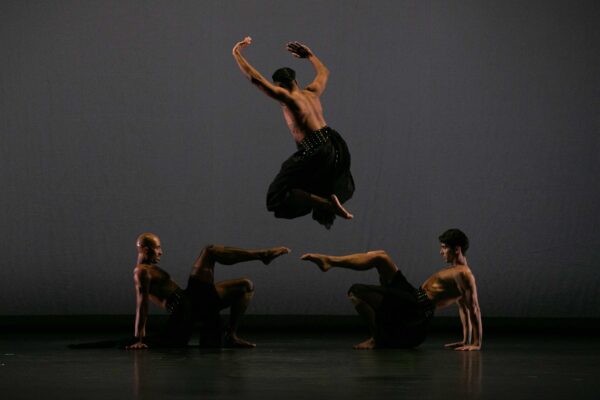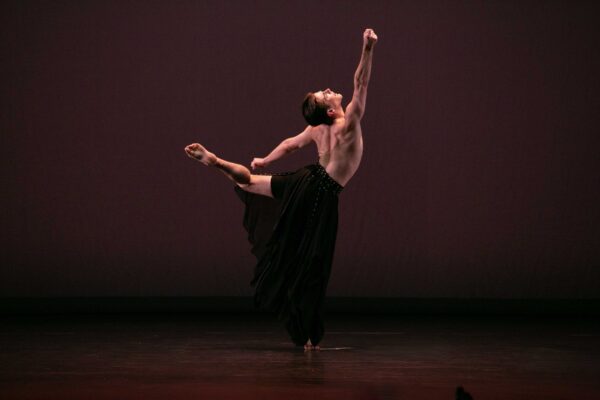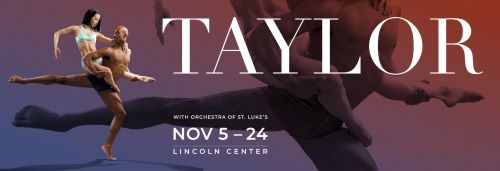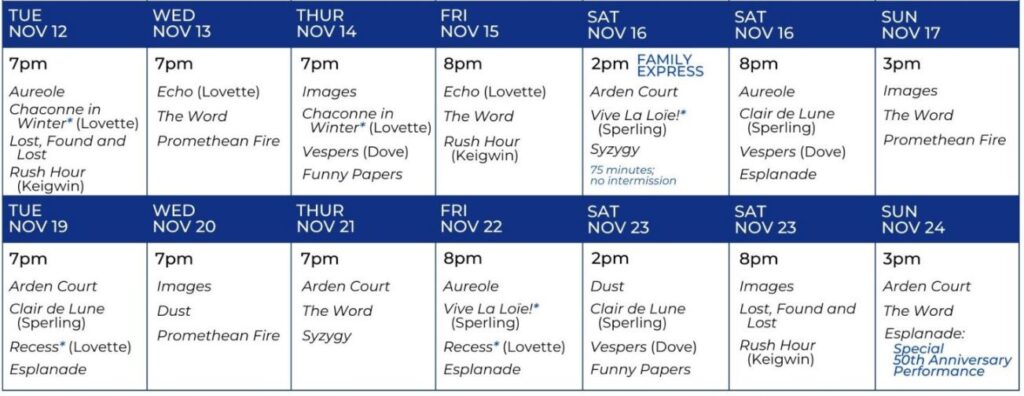Modern dance was born as a protest, a reaction to the rigid structure of classical ballet. As is evident from my review of the dazzling program Extreme Taylor at the Joyce in June, I couldn’t wait to see the company again, to explore more of their movement vocabulary. Now, the Paul Taylor Dance Company is back with a three-week fall program at Lincoln Center with a combined total of 18 dances: 10 Paul Taylor classics, world premieres by choreographer Lauren Lovette, Robert Battle, and Jody Sperling, and acclaimed works by Ulysses Dove and Larry Keigwin. Playing through November 24 at The Koch Theater, there is a dizzying array of programs, different on each day and accompanied by the Orchestra of St. Luke’s; you may find yourself attending more than one. No matter when you go, you simply can’t lose.
Aureole with Devon Louis and Maria Ambrose (Steven Pisano)
I was lucky to catch two shows; the first one on November 5 featured Aureole (1962), Dust (1977), and Lovette’s Echo (2023), with music performed live by the supreme Orchestra of St. Luke’s, conducted by David LaMarche, and a special appearance by Time For Three who performed for Echo. I must say that Aureole, the first dance, shocked me for its resemblance to ballet; graceful, classical, I had to check the program to make sure it was choreographed by Taylor. Then I learned that in the mid 50s, when he befriended Robert Rauschenberg, the painter introduced him to other avant-garde artists like Jasper Johns, John Cage, and Ellsworth Kelly. They became great friends and they all collaborated on Taylor’s radical choreographies until 1962, when Taylor premiered Aureole and it became a major success, his first. This infuriated his modernist friends who could not stand Aureole’s triviality, its resemblance to ballet. Set to music by George Frideric Handel, with lighting by Thomas Skelton, the piece is a mix of traditional and modern dance and its striking solo was famously performed first by Taylor, then by Rudolf Nureyev. Devon Louis stayed faithful to the original interpretation delivering a fluid and effortless looking solo. Maria Ambrose, Alex Clayton, Kristin Draucker and Jada Pearman were also watertight; sequences of perfect chassés, pirouettes, sautés, and jetés interconnected with precise v-shaped arms poses, glides and darts, in a happy, light harmony throughout the piece.
Heather McGinley, Sean Mahoney, Michelle Fleet, James Samson in Dust (photo by Paul B. Goode)
Laura Halzack in Dust (photo by Paul B. Goode)
Aileen Roehl, James Samson, Robert Kleinendorst, Eran Bugge, Michelle Fleet, Christina Markham, Sean Mahoney, Heather McGinley, Laura Halzack in Dust (photo Paul B. Goode)
Dust was first performed in 1977 with cheerful music by Francis Poulenc, glowing body stockings by Gene Moore, and lighting by Jennifer Tipton. The intermission before it helped because the show went from lyrical to strangely macabre; the curtain went up on a dark stage with a big black knotted rope that hung from the flies to indicate some sort of depth, like a void in hell. Nine dancers, Madelyn Ho, Lee Duveneck, Lisa Borres Casey, Jake Vincent, Jessica Ferretti, and Emmy Wildermuth, with Clayton, Draucker and Pearman, performed a ritualistic dance, some with their bodies entangled, some creeping around covered by black mantles, the rest moving fluidly straightforward. Madelyn Ho began a poetic solo, looking up at the rope in fear and hope, mixing with the rest of the lost souls and becoming like them, blind. Suddenly the dancers paired up, some turning continuously strapped to each other’s waists, doing cartwheels, others swinging from neck to neck, bringing joy to what looked like a doomed future.
Shawn Lesniak, Devon Louis, Jake Vincent, Austin Kelly in Echo by Lauren Lovette (photo by Whitney Browne)
 Shawn Lesniak, Devon Louis, Kenny Corrigan in Echo by Lauren Lovette (photo by Whitney Browne)
Shawn Lesniak, Devon Louis, Kenny Corrigan in Echo by Lauren Lovette (photo by Whitney Browne) Jake Vincent in Echo by Lauren Lovette (photo by Whitney Browne)
Jake Vincent in Echo by Lauren Lovette (photo by Whitney Browne)Lauren Lovette’s Echo was the only modern dance in the program and the piece that closed the show. Lovette was a Principal with the New York City Ballet before becoming a choreographer in her own right, and the company’s resident choreographer. She created an inventive, kinetic piece for eight male dancers, supported by a fascinating and exhilarating score by Pulitzer Prize and Grammy-winning composer Kevin Puts that complemented the choreography faultlessly, delivered by the Orchestra of St. Luke’s and classically trained string trio Time for Three (Charlie Yang and Nicholas Kendall on violin and Ranaan Meyer on double bass.) Duveneck, Clayton, Louis, Vincent with John Harnage, Shawn Lesniak, Austin Kelly, and Kenny Corrigan never stopped moving on and around the large stage, wearing black layered skirt-pants (that reminded me of Japanese warriors) designed for them by Zac Posen, in what appeared to be a primal ceremony, or a ritual, where all the dancers revealed their strength and incredible athletic power.
The excellent program left me in anticipation of the next evening’s program on November 7: three classics: Arden Court; Lost, Found and Lost; and Syzygy.
Madelyn Ho, Devon Louis, and Company in Arden Court (Ron Thiele)
John Harnage and Eran Bugge in Arden Court (Whitney Browne)
This was a completely different trip, a true immersion in the ‘80s. Arden Court, the first dance, was a portrayal of love, moving, dreamy, and passionate. First performed in 1981, it displayed all the iconic movements of Taylor’s vocabulary. On stage, in front of Gene Moore’s backdrop featuring a painted, giant red rose (Taylor’s mother’s favorite flower,) illuminated by Tipton’s light design, Duveneck, Clayton, Louis, Harnage, Kelly, and Corrigan jumped, vaulted, rolled on the floor, showing off their bodies and precision, being manly but playful. They were the heart of the dance performing adagios, usually reserved to female dancers, and acrobatic, eccentric feats, bridging light and dark as the Maestro intended. When Madelyn Ho, Lisa Borres Casey, and Jessica Ferretti entered stage, the courtship began and the athleticism turned into poetry; some of the duets were memorable, it is a magnificent dance.
Laura Halzack, Parisa Kohobdeh, Michelle Fleet, Eran Bugge, and Amy Young in Paul Taylor's Lost, Found and Lost (photo by Paul B. Goode)
Laura Halzack in Paul Taylor's Lost, Found and Lost (photo by Paul B. Goode)
Lost, Found and Lost (1982) felt more like a study of posture and ordinary gestures, movement and non-movement, with black costumes and white stage design by Alex Katz, surrounded by clever elevator music arranged by Donald York, all based, as the sugar-coated ‘80s, on lightness and imagery.
Kenny Corrigan, Alex Clayton, Devon Louis, Austin Kelly, Lee Duveneck, Shawn Lesniak in Syzygy by Paul Taylor (photo by Ben McKeown)
Alex Clayton, Kenny Corrigan in Syzygy by Paul Taylor (photo by Ben McKeown)
In the last piece, Syzygy (1987), dancers dashed across stage like celestial bodies, “orbiting and eclipsing each other.” Syzygy, in astronomy, is the nearly straight-line configuration of three celestial bodies (such as the sun, moon, and earth during an eclipse,) but in Taylor’s work there were 13 ‘celestial bodies’ on stage, all moving wildly in suitable costumes by Santo Loquasto, often ending up in multiple ingenious combinations. Madelyn Ho elegantly led the ensemble, light as a feather and hard as a bamboo branch. I have just found out that she graduated from Harvard College with a B.A. in Chemical and Physical Biology while dancing professionally; she joined the Paul Taylor Dance Company in Spring 2015 and completed her Doctorate of Medicine at Harvard in May 2018. She is such an inspiration! As I wrote before, any show by this company is a slam dunk if only for the amazing dancers and the power behind them, the artistic genius of Paul Taylor. I liked the first program a bit more then the second one but it is a question of taste, nothing to do with the shows. Go see them whenever and wherever they perform, it is worth it.
Madelyn Ho in Syzygy by Paul Taylor (photo by Ben McKeown)
Paul Taylor Dance Company
David H. Koch Theater at Lincoln Center for its annual Fall Season
ends on November 24, 2024
for tickets (starting at $15), visit the Koch Theater
Other fall season dances:
Maria Ambrose, Shawn Lesniak, Lee Duveneck, and Company in The Word (photo Luke J. Merlino)
John Harnage, Devon Louis, Lee Duveneck, and Maria Ambrose in Larry Keigwin's Rush Hour (photo by Whitney Browne)
Jessica Ferretti in Jody Sperling's Vive La Loie! (photo by Noah Aberlin)
The Company in Promethean Fire (photo by Jayme Halbritter)
Devon Louis, Madelyn Ho, and Company in Promethean Fire (photo by Jayme Halbritter)
John Harnage and Christina Lynch Markham in Promethean Fire (photo by John McCoy)
Lisa Borres with Jake Vincent, Kristin Draucker, Alex Clayton, Christina Lynch Markham, Lee Duveneck, and Jessica Ferretti in Esplanade (photo by Whitney Browne)
Jada Pearman, Jake Vincent, Kristin Draucker, and Company in Esplanade (photo Steven Pisano)
Jada Pearman in Esplanade (photo by Steven Pisano)


